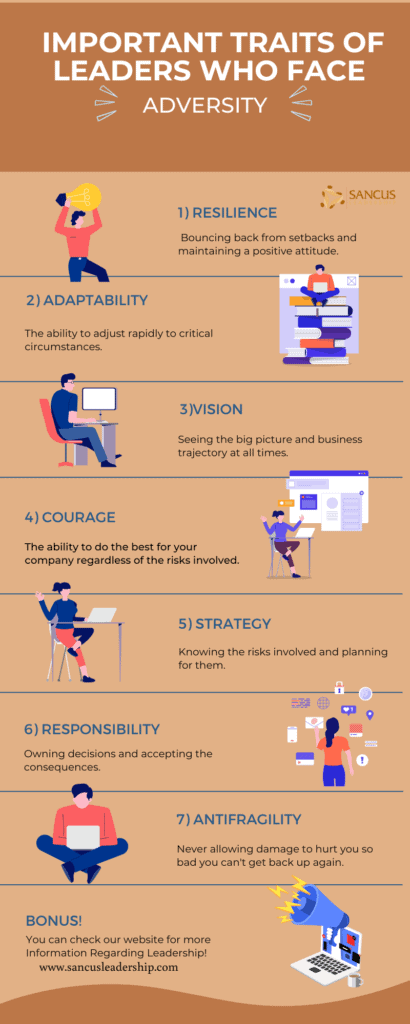The military has one secret that most business leadership development programs don’t know or fully understand; without adversity, you cannot have influential leaders. Adversity is like a blacksmith forging steel; through the heat and banging of the steel, he creates ten times more robust and durable metal. So what is adversity for leaders and managers, and how can it improve your capabilities?
Adversity promotes growth for leaders who appropriately respond to it. Adversity in leadership is any obstacle or setback that challenges a leader’s capabilities. While adversity is commonly perceived as unfavorable, it can be beneficial for leaders to learn creative solutions to problems.
Many of us think of adversity as a bad thing. However, in business (and life), there is a significant opportunity to use every setback to harden the “steel” of your leadership. Today I will discuss what adversity is in leadership, common examples of adversity, and traits of leaders who face adversity.
Adversity is like a blacksmith forging steel; through the heat and banging of the steel, he creates ten times more robust and durable metal.
What Does It Mean To Lead Through Adversity?

Leading through adversity means guiding others through difficult situations despite how challenging those situations may be.
While leading this way takes many forms, in all instances, it involves high-pressure situations with risks involved. Further, the outcome of those situations will directly result in significant growth or detriment to a company.
In the face of adversity, leaders must take certain risks and accept the consequences of their actions, regardless of the outcome. Because of the rugged nature of business, managers will also need to be flexible and adapt to new challenges.
Additionally, while managers have to take necessary risks during adversity, they must remain calm and act out of reason rather than passion.
All of these factors make leading through adversity incredibly challenging. However, this management form is also the most rewarding and provides the most growth for the individual and company.
No company has a direct trajectory to the top. All businesses face adversity. Leaders who use adversity to their advantage and overcome it generate the most growth for their companies.
I hate to say it, so I will sing it instead “what doesn’t kill you, makes you stronger” ( I promise, there are no more clichés in this article).
Here is Col Andy Anil sharing his own leadership experiences under adversity.
What Are Common Examples of Adversity in Leadership?

Adversity comes in many forms, and knowing specific ways it can arise can help you respond to adversity appropriately and creatively. In general, adversity comes from personal, workplace, or environmental factors.
Personal Adversity
Personal adversity arises when personal issues with direct employees are under your control.
Examples of this adversity type include:
- Health issues that prevent an individual from doing their job
- Absentee or tardiness issues
- Disrespect or direct insubordination
You can address these issues one-on-one with the employee and, in some cases, may result in their termination or transfer to a new job type (although I usually see this solution as a failure of leadership).
In these situations, it’s crucial to show empathy and understanding and be your employee’s friend who truly cares for them.
Be direct and transparent with your communication! Find a solution that aligns with your moral code and the company ethos.
Workplace Adversity
Workplace adversity is the most common form and arises from issues within the business itself, such as cash flow problems.
Examples of workplace adversity include:
- Financial issues
- New ownership or an organizational merger
- Increased competition from similar companies
- High employee turnover rate or low employee morale
Leaders respond to workplace adversity by restructuring the organization, enacting new policies, or being creative with a functional alternative.
If the solution requires a new policy, layoffs, or structural changes, managers must also interact one-on-one or in team meetings with employees to inform them about the updates.
While these changes will generally be unpleasant for employees, consider the business trajectory and make decisions that benefit in the long term.
Effective leaders have an eye for the future and are resilient in the face of dramatic changes.
Environmental Adversity
Environmental adversity is any challenge from an outside source that you cannot adequately prepare for or influence ahead of time.
Environmental adversity examples include:
- Natural disasters, pandemics, or other crises
- Political or legislature changes
- The introduction of a new and disruptive technology
| Types of Adversities | Examples of Adversities |
| Personal Adversity | Health issues that affect job performance, absenteeism or tardiness, and disrespect or insubordination towards the supervisor |
| Workplace Adversity | Financial problems, Organizational mergers or changes in ownership, Increased competition, and High employee turnover rate or low morale |
| Environmental Adversity | Natural disasters, pandemics, or other crises, Political or legislative changes, and introduction of new disruptive technologies |
This adversity is incredibly challenging because there’s no way to prepare for the event or its aftermath. Leaders must be resilient and creative to develop appropriate solutions to these situations.
What Are the Traits of Leaders Who Face Adversity?

Leaders who face adversity and grow from it are noteworthy individuals with several specific traits that help them weather the storm and rebuild to greater heights. These traits contribute to remaining calm under pressure, guiding others, and maintaining long-term goals.
Leaders who face adversity and grow from it are noteworthy individuals with several specific traits that help them weather the storm and rebuild to greater heights.
The following are the most important traits of leaders who face adversity:
- Resilience: bouncing back from setbacks and maintaining a positive attitude.
- Adaptability: the ability to adjust rapidly to critical circumstances.
- Vision: seeing the big picture and business trajectory at all times.
- Courage: the ability to do the best for your company regardless of the risks involved.
- Strategy: knowing the risks involved and planning for them.
- Responsibility: owning decisions and accepting the consequences.
- Antifragility: never allowing damage to hurt you so bad you can’t get back up again.

Individuals in management positions can adopt these traits to improve their leadership skills in adversity.
While we generally think of adversity as a setback of limitation, effective managers use adversity to grow themselves and others. They must be resilient during tough times and able to respond creatively to their situation.
Further, these individuals not only react at the moment but also consider the long-term trajectory of their business. They have the vision to know where to go, the courage to see things through, and the strategy to mitigate risks so everyone benefits.
Finally, leaders must be responsible for their actions and antifragile. Antifragility is a recent term popularized by Nassim Taleb that refers to systems that grow stronger from stress rather than weaker.
Nassim also wrote the book Antifragile: Things That Gain from Disorder, it is a great read, and I recommend you get a copy if you want to understand better how to learn from adversity.
Antifragile leaders have strategies to grow or evolve in the face of adversity. These individuals are not only resilient when facing problems, but they also get better at facing those problems in the future.
Conclusion
Most leaders are effective when things are going well. However, when faced with adversity, true leaders and managers stand out as a source of guidance.
Adversity in leadership is any trial or setback that threatens the equilibrium of a business. Leaders who overcome adversity use these trials to improve their businesses and themselves.
Adversity can take many forms, but it often involves a single person, an entire company, or environmental influences out of anyone’s control.
Traits of leaders who face adversity and overcome it include adaptability, vision, responsibility, and antifragility.



